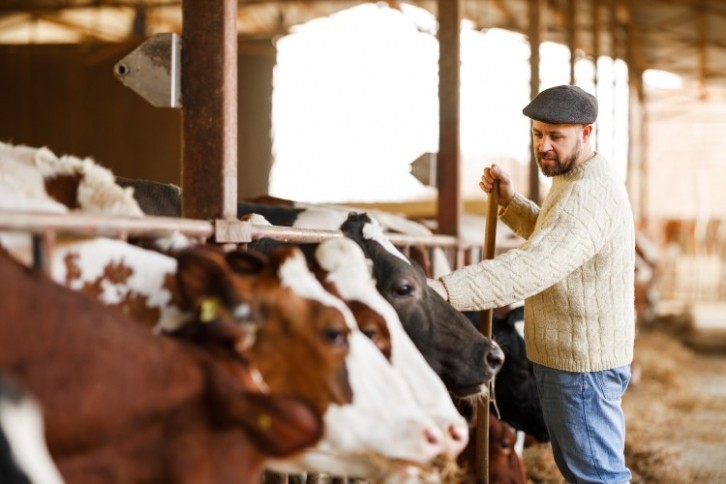Smart reproduction management could boost milk sustainability, farm income

Researchers from Wageningen University in the Netherlands hypothesized that adjusting the replacement rate of dairy heifers could improve milk’s climate impact as well as farmer profitability. They measured how increasing the artificial insemination (AI) attempts and cow culling rate based on different dry period lengths affected revenues, treatment and feed costs and the amount of carbon associated with milk production.
Typically, dairy cows are inseminated up to 4 times and those that cannot reproduce are culled when their milk production drops to 15kg per day. These metrics are based on the assumption that replacement heifers are abundantly available, but this isn’t always the case, the researchers said.
In a study that used a bio-economic model developed to simulate Dutch dairy herds of 100 cows, the researchers found that increasing the number of times a cow is inseminated from 4 to 6 was linked with improved partial net returns for the farmer as well as a reduction in greenhouse gas emissions from milk.
Meanwhile, setting a lower reproductive culling threshold – e.g. 10kg of milk per day - may add up to five a half months to a cow’s life, though this didn’t lead to an increase in revenue or GHG emissions reductions, the authors noted.
“We modeled farmers' commonly used decision rules of thumb for determining when to cease inseminating cows (i.e., adhering to a maximum of 4 inseminations) and when to cull non-pregnant cows (i.e., when daily milk yield drops 15kg a day). It is clear that the use of these straightforward decision rules is not optimal,” the researchers wrote in their paper, published in the Journal of Dairy Science (see ‘sources’ below).
Overall, GHG emissions decreased by 1.2% - from 0.926 to 0.915 kg CO2 equivalents per kg fat and protein-corrected milk when the number of inseminations was increased from 4 to 6.
But depending on when cows were culled could actually have a detrimental effect on emissions. For example, longer lifetimes were not associated with lower emissions; in fact emissions increased by 0.2% when cows were culled later (when they could only produce 10kg of milk per day) compared with when the animals were culled at a 20kg per day threshold.
Similarly, increasing the number of times a cow was inseminated was not linked with increased cattle longevity – but the increasing of AI interventions did result in increase in the farm’s partial net return and a reduction of GHG emissions.
“With an increase in the maximum number of AIs, all technical variables except for the culling rate show an upward trend,” the researchers stated. This included milk production, which increased from 8 616kg to 8 682kg per cow after the sixth AI.
“The impact on the age at culling is larger when shifting from a maximum of 4 to 5 Ais…than from 5 to 6,” the researchers concluded. “Decreasing the threshold for reproductive culling from a milk yield of 20 to 10 kg/day increased age at culling, but decreased all other technical indicators of performance,” including milk production, number of calves, but also mastitis and lameness incidence.
Economically, partial net return increased when more than 4 AIs were conducted, and decreased when lower thresholds of reproductive culling were set. However, while revenues from milk and calves increased 0.7% and 5.7% respectively when the number of AIs was raised from 4 to 6, revenue from meat fell 11%. Costs for feed and others were also higher the more AIs were conducted, though replacement costs decreased.
The increased maximum number of AIs also decreased the carbon emissions in milk, but there was no difference in GHG emissions per kg of FPCM when the culling threshold was increased from 15 to 20kg per day.
However, partial net returns were also the highest when cows were culled at the 20kg/day threshold, and decreased at the other two dry period lengths.
"Our results demonstrate that increased longevity by adjusted reproduction management decisions can benefit both farmers' income and GHG emissions," the authors concluded. "Moreover, it is not longevity itself that leads to a change in environmental and economic efficiency, but rather the method by which this extension of longevity is achieved.
"In contrast to merely adjusting the decision rule for the timing of reproductive culling, increasing artificial insemination attempts can enhance the sustainability of dairy farming from both economic and environmental perspectives."
Source:
Effects of extending dairy cow longevity by adjusted reproduction management decisions on partial net return and greenhouse gas emissions: A dynamic stochastic herd simulation study
Authors: Ruozhu Han, Akke Kok, Monique Mourits, Henk Hogeveen
Published: Journal of Dairy Science, April 24, 2024
DOI:https://doi.org/10.3168/jds.2023-24089






